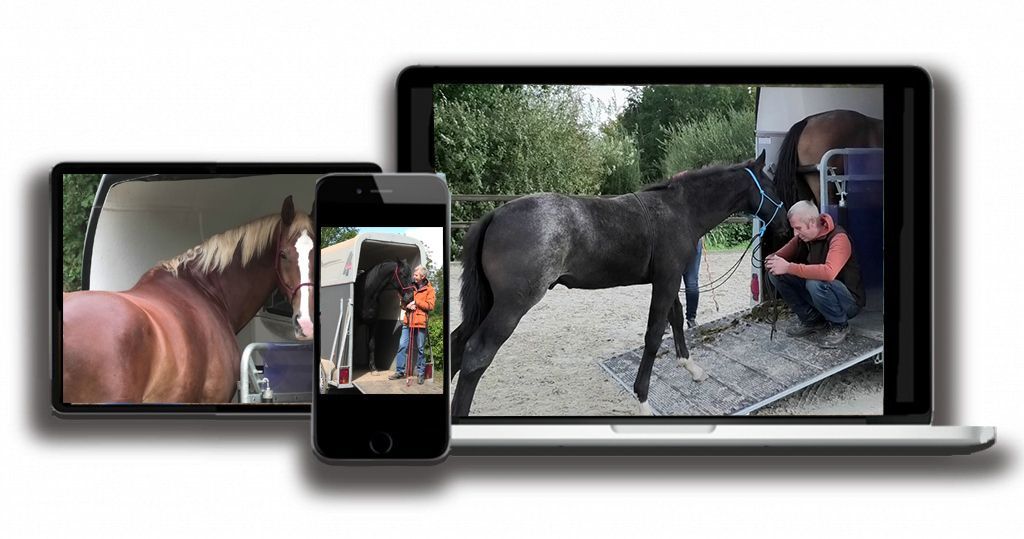Trailer loading issues
Why is trailerloading for horses such a problem?
Many people may have experienced that loading a trailer can be a problem. It is not to be blamed on your horse for not wanting to enter the trailer, as it is a purely instinctive reaction of your horse for self-preservation.

Loading a trailer can be problematic due to a horse's instinct to avoid narrow spaces. Building trust and leadership is essential for successful trailer loading. Force and punishment make the horse distrustful. Instead, use a natural approach, giving the horse time to relax near the trailer.Horses have avoided narrow spaces for millions of years. Every prey animal knows that you should never let yourself be backed into a corner, and that includes a narrow space like a trailer. A trailer has a ceiling, a floor, a wall on the left, a wall on the right, a front, and a back.
In the eyes of a horse, a trailer is nothing more than a metal cage on wheels, a trap that you walk into.

A trailer-loading issue has nothing to do with the trailer itself. It usually involves the relationship between you and your horse. It's about the sense of trust the horse has in you and about your leadership. The more you force him, the less he will trust you and the less he will follow your cues. Success in easily loading your horse into the trailer starts outside the trailer. You need to understand how to gain the trust, respect, and leadership of your horse so that he understands what you want from him. Trailer loading is a one-off event, but if you suddenly need to take your horse somewhere, it's nice if he just gets in.

The more your horse trusts you, the less likely he will say no to trailer loading. Learn to communicate in a language that is as natural as possible for your horse, so that he understands what you mean and can willingly carry out the commands.
The conditioned response, comfortable and uncomfortable.
We all know that you can force a horse into the trailer with violence and quickly close the ramp. However, there is a better way to acclimate your horse. By using a natural approach that is much less frustrating and dangerous for both horse and human. Most people force, punish, and put pressure on a horse near a trailer, so it's no wonder the horse starts to dislike the trailer. If you lead him near the trailer without force and then leave him alone, giving him his comfort, things will start to change.

Work with him at a distance from the trailer and then bring him back to the trailer. Leave him alone and give him time to relax. He will start to see the trailer as a place of safety, peace, and sanctuary rather than a place of coercion, pushing, pulling, and confinement. He will begin to associate it with comfort rather than discomfort, and he will be much more relaxed near the trailer. With good communication, leadership, and building trust, the horse will eventually do what you ask of him..
Do not wait too long to teach it, but also do not neglect the maintenance of trailer loading. Imagine if you unexpectedly need to go to the clinic, it is nice that your horse is accustomed to walking in the trailer. Or if you want to do something fun like compete or go on a beautiful trail ride, if your horse doesn't want to go in the trailer, it can be quite a downer.
We therefore recommend taking ownership of trailer loading and regularly practicing it to avoid any issues when you actually need to use the trailer.
If you want to learn all the tips we have gathered on trailer loading, you can do so from home at your own pace through our online trailer loading course.
Read more information about the Course Trailer Loading here.

If you would like a private lesson to work together with me on helping your horse with the trailer, please send an email to humphreydirkshorsemanship@gmail.com or use the contact form.
Safety tips
- Once your horse is calm enough to stand in the trailer for 10 seconds, you can place the bar, but make sure to immediately close the safety hooks of the bar points to prevent the horse from leaning against or underneath it and pushing the bar out with all the consequences that may ensue.
- Never, under any circumstances, close the trailer ramp without first placing the bar behind the horse's hindquarters, as this can lead to a serious accident for both. If the horse backs up while you are lifting the ramp, you could end up under the ramp and in the hospital.
- The front door of the trailer is meant for the handler, not for the horse. Some horses may try to see if they can exit through this door. Always close this door immediately after use, so your horse doesn't get the urge to push against it. It may seem unnecessary to say, but have your trailer checked by a specialist every year. We don't want a horse to fall through the ramp or floor, or for the brake not to function properly. Safety comes first.
- Do not tie your horse to the halter in the trailer if you haven't placed the bar behind the hindquarters yet. If the horse panics and pulls back, it could fall over and seriously injure itself. So, always secure the bar first, close the safety lock of the bar, and then tie up your horse.

Have a safe journey ..........








